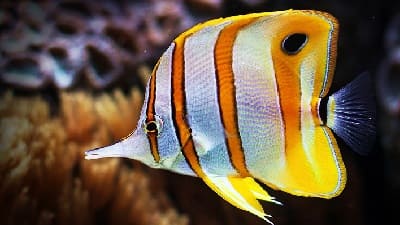Home › Sea Creatures › Marine Animals › Vertebrates › Butterfly Fish
Interesting Facts about Butterfly Fish
[Phylum: Chordata] [Class: Actinopterygii] [Order: Perciformes] [Family: Chaetodontidae]
Marine biologists recognise more than 129 different species of butterfly fishes of the family Chaetodontidae, which also includes bannerfish and coralfish.
This section contains fun facts and interesting information about the butterfly fish genus, where to find them, what they eat, and how they reproduce.
Butterflyfish Habitat and World Distribution
The general appearance of this large family of tropical marine fishes is bold and conspicuous.
By and large, you will find them parading around shallow coral reefs in the Atlantic, Pacific, and Indian Oceans.
To the untrained eye, butterflyfish bear a resemblance to the saltwater angelfish (Pomacanthidae) and the Moorish idol (Zanclus cornutus).
However, the absence of the preopercle membrane, and spines around the gills, clearly sets them apart.
There are some weird fish names in existence. But, the common name of this species refers to its illuminating body patterns. The colours and shades range from black, blue, red, yellow, white, and orange.
Characteristics of Butterflyfishes
It would be rare for any of the butterflyfish species to grow much bigger than twenty two (22) centimetres long (8 inches). In fact, the average length for most of the genus is closer to twelve (12) centimetres (4 inches).
Much like those seen on the wings of many butterflies, the fish has similar eyespots on the flanks, often with dark stripes running across the eyes.
Here's the thing:
Other distinguishing features are the deep, laterally compressed body shape and the uninterrupted dorsal fin. By and large, the caudal fin is round or truncated (short), but never ends in two prongs (forked)!
Fun Fact: The lined butterfly fish (Chaetodon lineolatus) and the saddle butterflyfish (Chaetodon ephippium) are the two largest members in the species, each measuring up to thirty (30) centimetres long (12 inches).
What Do Butterfly Fish Eat?
In general, butterflyfishes are territorial creatures and most active during the daylight hours (diurnal). Even so, it would be unusual to find them swimming around any underwater habitats deeper than eighteen (18) metres (59 feet).
 The butterfly fish is a typical corallivore that feeds most on:
The butterfly fish is a typical corallivore that feeds most on:
- Coral reef polyps (soft-bodied organisms)
- Invertebrate sea anemones
- Microscopic organisms (zooplankton)
They often swim and eat in pairs, usually laying claim to a specific coral head when feeding.
But, butterflyfish become very timid during the darkness and they will take refuge in reef fissures and crevices.
Pro Tip: Many of the dive sites in southeast Asia offer ideal opportunities to catch sightings of this species as they search for food scraps, especially around artificial reef structures and sunken shipwrecks.
Butterflyfish Species List
Atoll Butterflyfish
Chaetodon mertensii is one of the lesser-known butterflyfishes characterised by its psychedelic colouring and captivating body patterns.
This section contains fun facts and interesting information about the merten's butterflyfish (aka the atoll butterflyfish), including where they live, what they eat, and how they reproduce.
Blackback Butterflyfish
Copperband Butterflyfish
Eight-Banded Butterflyfish
Foureye Butterflyfish
Lined Butterflyfish
Ornate Butterflyfish
Pennant Coralfish
Raccoon Butterflyfish
Redtail Butterflyfish
Saddle Butterflyfish
Schooling Bannerfish
As the common name suggests, there is a schooling species of bannerfish that enjoys swimming together in large groups around shallow coral reefs.
The blog contains fun facts and interesting information about schooling bannerfish (Heniochus diphreutes), including where they live, what they eat, and how they reproduce.
Speckled Butterflyfish
Sunburst Butterflyfish
Teardrop Butterflyfish
Threadfin Butterflyfish
Vagabond Butterflyfish
Wiebel's Butterflyfish
Wrought-Iron Butterflyfish
Butterfly Fish Reproduction
Because butterfly fish are broadcast spawners, they release large numbers of buoyant, pelagic eggs into the open water near to the surface.
The eggs float with planktonic organisms in the currents until they hatch, usually within a day of fertilisation taking place.
Following that, the tiny fry enter the postlarval stage of Chaetodontidae and Scatophagidae (also called tholichthys stage). Simply put, large, bony armour plates extend from the head and cover the rest of the body in some of the postlarval fish species until they reach maturity.
Threats and Predators
Interesting Fact: The threat status for butterflyfishes is of 'Least Concern' (LC) according to the information on the International Union for Conservation of Nature (IUCN) website.
Fun Fact: Having a vivid and conspicuous colouration means they are popular fish for aquarium hobbyists to keep as pets.
Related Information and Help Guides
- Best Dive Sites for the Mediterranean Cardinalfish
- Blenny Fish Facts and Species Information with Pictures
- Blue Dragon Sea Slug Facts and Information
- Flashlight Fish Facts and Species Information with Pictures
- List of Marine Vertebrates Fish Examples for Beginners
- Wrasse Fish Facts and Species Information with Video
Note: The short video [2:33 seconds] presented by "Animal Planet" contains footage of different butterfly fish species swimming and feeding in their natural habitat.